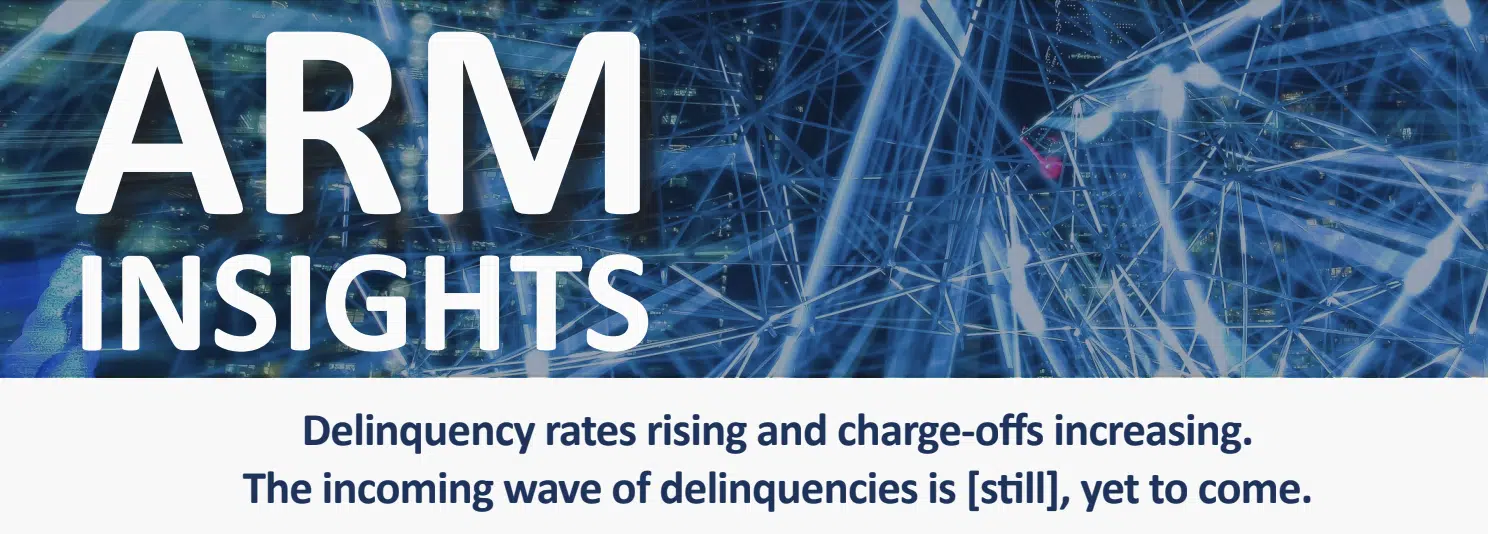Some text
Accounts Receivable Management (ARM): Delinquency rates rising and charge offs increasing. The incoming wave of delinquencies is still, however, yet to come.
As generative AI is poised to take over the world, the collections industry keeps on chugging along. There are interesting tailwinds (notably increasing delinquency rates and the feeling of economic slowdown, although there is zero data that supports the claim) that should impact the ARM industry over the coming quarters. Deal volume is down as most companies are focusing on internal processes and procedures (most notably the use case of technology in their internal operations), while optimizing workflows heading into the slow part of the year prior to tax season. We anticipate that there will be some strategic deals completed in the remainder of the year, but most of the larger processes will likely hold off until after Q1 2024 when we have a better sense of the economic conditions that consumers will be facing.
The Federal Reserve Bank of New York conducted research on “buy now, pay later” (BNPL) users and found that they are often financially fragile, with about one-third of users having low credit scores, credit application rejections, or loan delinquencies in the past year. This raises concerns about the resilience of BNPL lending during economic shocks. The study also revealed that BNPL availability and use are widespread, with 64% of respondents receiving BNPL offers, and 29% using it as a payment method in the past year. BNPL is commonly used for installment payments, primarily via debit cards, bank accounts, or checks. Women, renters, those without a college degree, and lower-income consumers are more likely to use BNPL. Interestingly, even those with credit issues were more likely to be offered BNPL. However, researchers noted potential risks of overextension and excessive debt accumulation among BNPL users, especially those already financially vulnerable. The lack of BNPL data reporting to credit bureaus could exacerbate these risks. These findings align with earlier research suggesting that BNPL users tend to seek and use more credit, and their credit scores are lower than non-users.
Over 30 million federal student loan borrowers resumed their student loan payments on October 1 after multiple pauses in the last three years. These pauses were initially enacted in March 2020 due to the pandemic and provided relief to nearly 44 million borrowers. Student loan interest resumed on September 1, 2023, and the U.S. Department of Education scheduled October 1 as the date for payments to restart. For borrowers whose payments are resuming on October 1, the Department of Education is implementing a 12-month plan. During this period, borrowers who miss payments from October 1, 2023, to September 30, 2024, will not face consequences like being reported to credit bureaus or placed in default. This is essentially a forbearance period to help borrowers ease back into repayment. However, borrowers may still receive delinquency notices, which could be confusing to some. The resumption of payments could be challenging for both borrowers and loan servicers. Loan servicers are encouraging borrowers to contact them in advance to address any concerns or questions. Additionally, the system may face difficulties processing payments from many borrowers, and some borrowers may struggle to budget for their loan payments after the extended pause.
The Department of Education is working on a permanent contracting approach to enhance loan servicing stability and transparency to replace the current plan. The goal is to streamline student loan repayment with contracted servicers, improving the customer experience and support for at-risk borrowers (who are currently only going to be serviced by a single group handling all defaults on behalf of the DoE – MAXIMUS Federal Services, Inc). When the forbearance period ends in October 2024, this will be an interesting trend to monitor with a sole group handling all delinquencies for a 1.6T asset class.
The student loan debt crisis in the United States is a pressing issue, with borrowers facing an average debt of $37,593 and a staggering total debt of $1.6 trillion (with federal loans accounting for more than 90% of it). This crisis exerts a multifaceted impact on the economy and borrowers’ personal lives. High levels of student debt make it more challenging for borrowers to become homeowners, ultimately slowing down the housing market, while also discouraging entrepreneurship/consumer spending. However, a recent report from NY Fed seems to indicate that the student loan payment resumption will have a relatively small impact on consumption, and thus, the economy. We at CAS remain skeptical, and will be watching the trends closely.
The Consumer Financial Protection Bureau (CFPB) report on student loan complaints and trends reveals several critical insights in the current student loan landscape. Over the period spanning September 2022 to August 2023, the CFPB received a substantial volume of complaints, exceeding 9,000 in total. Of these, 75% related to federal student loans, while the remaining 25% concerned private student loans. Notably, complaints regarding federal student loans demonstrated an upward trajectory, with issues such as extended customer service wait times, servicing errors, and challenges accessing loan cancellation programs taking center stage. The report highlights the complexity of servicing transfers, affecting over 20 million federal loan accounts since 2020 and potentially leading to payment history errors that can influence borrowers’ eligibility for loan cancellation. Private student loans, though representing a smaller fraction of the overall student debt landscape, generated about 25% of the complaints, predominantly centering on hurdles associated with accessing cancellation options and concerns about misleading origination practices. Again, another trend to focus on heading into 2024 and how this current issue will be resolved.
In the article “High-Debt Consumers Average 14 Late Payments Every Year” by pymnts.com, a study reveals that high-debt consumers grapple with an average of 14 late payments annually, alongside an increased likelihood of overdue payments and reliance on overdrafts to cover transactions compared to other consumers. Notably, approximately one-third of U.S. consumers carry outstanding debts exceeding $250,000, primarily comprising mortgage and auto loans. High-debt consumers are over twice as likely to hold auto loans, and 3 in 10 of them contend with overdue payments and resort to overdrafts more frequently. The article attributes the high incidence of late payments among such consumers to factors like financial literacy gaps, financial hardship, and potentially exploitative lending practices. The 14 late payments a year is an interesting data point for all agencies, law firms and debt buyers to consider when calling on a consumer… meaning you are likely not the only one. This trend will likely accelerate as economic conditions soften.
The Consumer Financial Protection Bureau (CFPB) in a recent report revealed they are in the process of considering several pivotal proposals aimed at regulating data broker activities under the Fair Credit Reporting Act (FCRA). These proposals encompass clarifying when data shared with third parties becomes a consumer report, irrespective of the data broker’s intent, strengthening definitions for credit header data, and addressing consumer reporting agency practices for targeted marketing. The CFPB is also exploring matters related to permissible purposes, data breaches, dispute investigations, medical debt credit reporting, and potential impacts on small entities. These proposals are poised to reshape the regulatory landscape for data brokers and consumer reporting agencies, with substantial implications for the industry at large. Staying abreast of these developments will be essential for industry stakeholders and something we at CAS will be monitoring closely.
The retail store credit card sector is facing a concerning trend as delinquency rates surge, with TransUnion data revealing an increase from 3.89% in Q2 2022 to 4.98% in Q2 2023. Several factors contribute to this worrisome rise, including the impact of record-high inflation, straining consumer budgets, and the Federal Reserve’s interest rate hikes, making borrowing more expensive and debt repayment challenging. Moreover, there are concerns about predatory lending practices that target vulnerable consumers with high-interest credit cards, trapping them in cycles of late payments and delinquencies. If delinquencies persist, retail store credit card issuers may need to tighten lending standards and raise interest rates, potentially limiting consumer access to these cards and reducing their utilization. While the retail store credit card segment represents around 10% of the total credit card market, the escalating delinquency rates warrant proactive measures from issuers to mitigate the problem, including increased outsourcing to agencies and considering debt sales as well.
ARM Done Deals:
Equabli raised $3.35M
Colleen AI raised a Seed Round
Comvest Partners invested into ClearOne Advantage
Learn more in our latest newsletter: CAS Q3 Newsletter 2023


